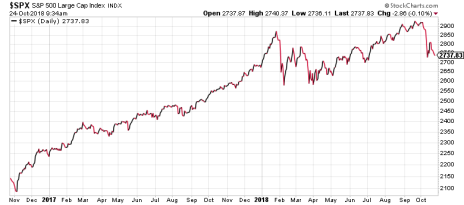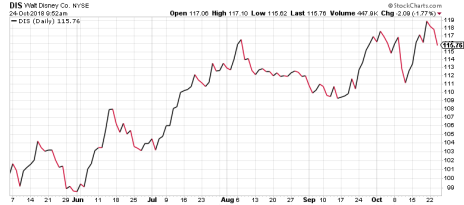Welcome to October! The stock market’s having a correction – again! – and investors are wondering whether to buy, sell or run and hide. I’ve been investing in stocks for 30 years, and I’m not worried at all, so I’d like to encourage you to relax. Besides, market corrections – even the biggest ones – don’t usually last for more than a few months. And the most popular large-cap stocks are likely to survive the temporary storm. More on those in a minute.
Maybe this will help: despite our second stock market correction of 2018, the S&P 500 is still up for the year. And look at this two-year price chart on the S&P 500. If you’ve been invested in index funds or popular large-cap stocks, you’ve probably increased your net worth by a nice amount in recent years.
The economy is booming and corporations are growing their profits. So unless you believe that this strong economic momentum is about to grind to a halt, it could be wise for you to move some money off the sidelines into the stock market right now, while stocks are on sale.
Here’s a quick review of a dozen of the largest FANG, information technology and communication stocks – in essence, the 12 most popular large-cap stocks today. The good news is that each company is expected to see profits grow in 2019. The bad news is that one percent earnings growth is not going to attract growth stock portfolio managers – the big boys who move the markets – when they can just as easily buy companies with 20% earnings growth. So put on your big boy thinking cap, and let’s see whether these famous companies offer a realistic prospect for capital gains in 2019.
Breaking Down the 12 Most Popular Large-Cap Stocks
First, we’ll speak to the investor who has a primary focus on dividends and a secondary focus on capital gains.
Yield Company
6.1% AT&T (T)
5.2% Verizon (VZ)
4.8% International Business Machines (IBM)
2.9% Cisco Systems (CSCO)
2.7% Intel (INTC)
AT&T offers a higher dividend yield, a lower debt-to-capitalization ratio, and a higher prospective 2019 earnings growth rate than Verizon and IBM. For dividend investors, the choice is easy: AT&T (T).
However, if you prefer decent earnings growth along with your dividend yield, there’s only one company in this list of high-dividend stocks that’s expected to see 2019 profits grow more than 3%. That company is Cisco Systems (CSCO), with expected 2019 earnings growth of 9.4%.
That was quick and easy! Now let’s talk to investors who love earnings growth. Surprisingly, there are only three companies within this large-cap dozen that are expected to see earnings growth of 20% or more in 2019. They each operate on a December fiscal year, so that makes comparisons easy.
2019 EPS
Growth Company
57.7% Netflix (NFLX)
46.2% Amazon.com (AMZN)
20.6% Alphabet (GOOGL)
All three are great companies with long-term growth outlooks, so pick your favorites. You might notice, though, that there’s not a single information technology stock among them. Therefore, if you happen to be heavily invested in tech stock mutual funds, you might rethink that strategy now.
What about value? Maybe you prefer companies with low price/earnings ratios (P/Es) or low debt ratios.
“Houston, we have a problem.” There are various ways to look at P/Es. I prefer to compare the P/E to the earnings growth rate, which is commonly measured by the PEG ratio. There’s only one company in this large-cap dozen that has a 2019 P/E that’s lower than it’s 2019 earnings growth rate, and that company is Apple (AAPL). At this time, Apple’s profits are expected to grow 16.8% in 2019 (September year-end), while the 2019 P/E is 16.2.
On the bright side, if you prefer to measure value by looking at the debt-to-capitalization ratio, you’re in luck! Your low-debt choices include Alphabet (GOOGL) and Facebook (FB), each with minuscule amounts of long-term debt.
Maybe you’re a trader, in which case your near-term capital gain prospects are far more important than debt ratios and dividends. Let’s first rule out any stocks that are trading at their annual lows. That’s because those share prices are likely to remain low through year end, due to tax-loss selling. Traders might therefore want to avoid Facebook (FB) and International Business Machines (IBM); and while Intel (INTC) is not trading at its low, it’s very close to it, so traders should likely avoid INTC as well.
Best Bets for Traders
- Walt Disney Co. (DIS) is breaking out of a long-term trading range to new highs, but hasn’t begun the real run-up yet. Buy Disney stock now.
- Verizon Communications (VZ) just shot up to new all-time highs. If there’s a brief pullback to 55.5, buy VZ.
- Netflix (NFLX) could rise 14% short-term to price resistance at 380. Buy NFLX now.
The only popular large-cap stock that I reviewed today that didn’t rise to the top of any one particular quantitative measurement was Microsoft (MSFT). Fear not! The company actually has good earnings growth prospects, a decent dividend yield, and a relatively bullish price chart. So if you own MSFT, keep it!
As you can see, there are always investment opportunities among popular large-cap stocks. As long as you’re focused on the aspects of stock investing that best fit your personal portfolio strategy, you can own shares of great companies that help you reach your financial goals.







